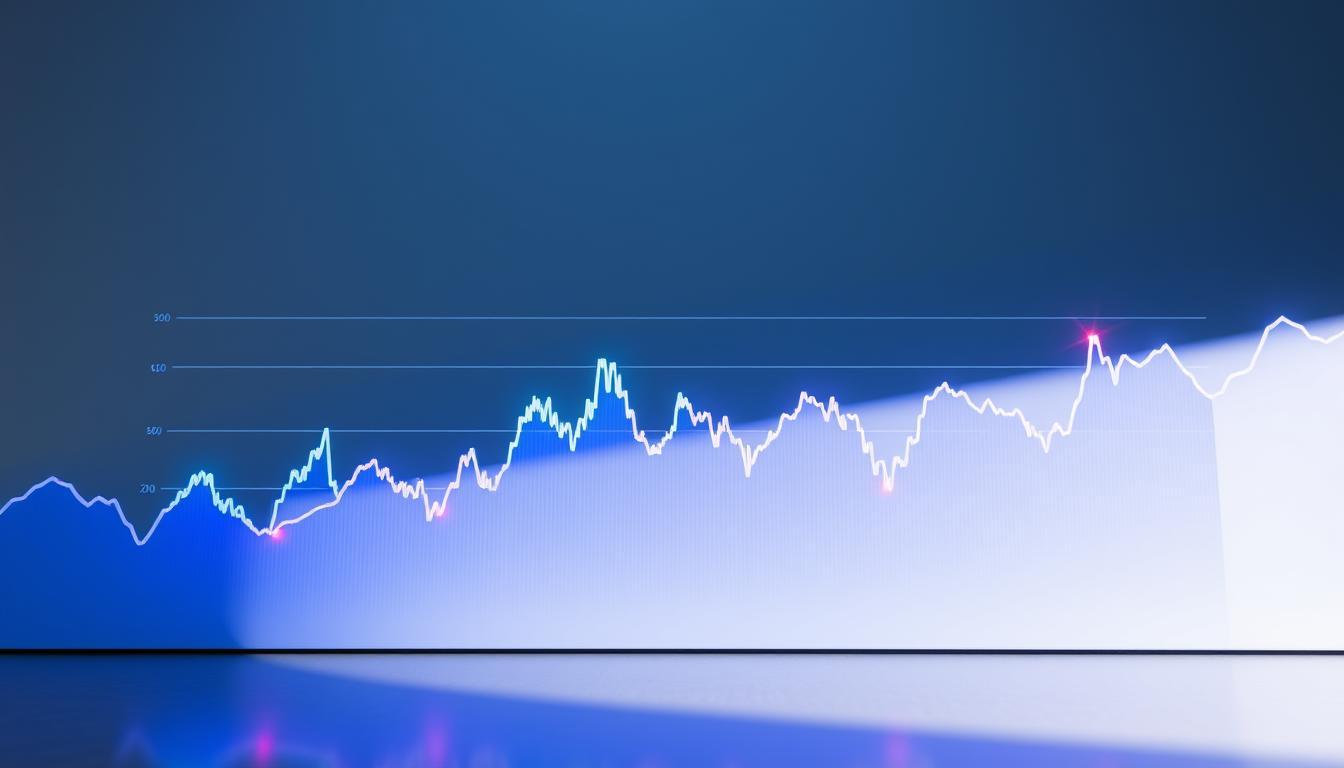Did you know that 30 companies collectively represent over $19.5 trillion in market value? This staggering figure forms the backbone of one of America’s oldest financial barometers, guiding investors through economic highs and lows since 1896.
Understanding this iconic index isn’t just about numbers—it’s about decoding the pulse of the economy. Unlike other benchmarks, its unique price-weighted structure gives everyday investors a clear snapshot of corporate giants’ performance. You’ll find it reflects everything from tech innovations to shifts in consumer behavior.
Why does this matter for your financial decisions? Movements here often signal broader economic trends, helping you spot opportunities before they become obvious. Whether you’re new to investing or refining your strategy, grasping these patterns could mean the difference between reacting to changes and anticipating them.
Key Takeaways
- Originated in 1896, tracking 30 major U.S. companies
- Price-weighted design prioritizes stock price over market cap
- Acts as a real-time economic health indicator
- Influences global investment strategies and decisions
- Current combined value exceeds $19.5 trillion
Introduction: Unveiling the Legacy of Dow Jones
Imagine tracking financial trends with pencil and paper—that’s how it all began. In 1884, Charles Dow, co-founder of The Wall Street Journal, published a simple stock average in the Customer’s Afternoon Letter. His list included nine railroads and two industrial companies, laying the foundation for modern market analysis.
This early experiment evolved into the Dow Jones Industrial Average we know today. The first official value? Just 40.94—a humble start compared to current figures. What made it revolutionary was its focus on real-world business performance rather than abstract theories.
Edward Jones, Dow’s collaborator, brought statistical rigor to the project. Together, they created a tool that simplified complex market data into actionable insights. Their work became essential reading in The Wall Street Journal, shaping investment strategies for over 140 years.
You might wonder why this history matters. Understanding these roots helps decode why the Dow Jones remains a trusted economic compass. It’s not just numbers—it’s a story of innovation that still guides decisions in boardrooms and living rooms alike.
Understanding dow jones stock markets Trends
What makes this benchmark stand out in a sea of financial metrics? The answer lies in its price-weighted design, a feature that prioritizes share prices over company size. While most indices weigh companies by market value, this approach gives higher-priced shares more sway over daily movements.
Here’s why this matters: A $5 shift in a $300 stock impacts the index more than the same change in a $50 stock. This creates unique patterns in market data interpretation. Broader indices like the S&P 500 spread influence across 500 companies, but here, just 30 blue-chip firms steer the trend.
“The index acts like a financial compass—its limited components amplify clarity during turbulent times.”
| Index | Components | Weighting Method | Volatility Factor |
|---|---|---|---|
| Jones Industrial | 30 | Price | Low-Moderate |
| S&P 500 | 500 | Market Cap | Moderate-High |
| Nasdaq Composite | 3,000+ | Market Cap | High |
You’ll notice fewer stocks mean higher concentration risk. But there’s a silver lining: established firms like those in the Jones Industrial group often stabilize swings during rapid market shifts. Their proven business models act as shock absorbers.
The math behind the scenes keeps things consistent. Add all 30 stock prices, then divide by 0.163—a divisor adjusted for splits. This ensures historical comparisons remain valid, turning raw numbers into actionable performance insights for your strategy.
Historical Evolution and Milestones of the Dow Jones
America’s economic resilience shines through the Dow Jones Industrial Average, tracing 125+ years of triumphs and trials. Born May 26, 1896, this benchmark faced its first crisis just months later during the Panic of 1896, plunging to 28.48 points.
The Roaring Twenties saw explosive growth. From 1920 to 1929, the industrial average rocketed 422%—soaring from 73 to 381 points. But the Great Depression brought devastation, erasing nearly 90% of its value by July 1932.
| Year | Milestone | Index Level |
|---|---|---|
| 1896 | Launch Date | 40.94 |
| 1896 | First Crisis Low | 28.48 |
| 1929 | Pre-Crash Peak | 381.17 |
| 1932 | Depression Bottom | 41.22 |
| 2024 | Record High | 42,544.22 |
Table shows pivotal moments shaping the index’s trajectory
You’ll notice 59 component changes reflect America’s economic shifts. General Electric held its spot from 1896 until 2018—a 122-year tenure showcasing industrial-era dominance. Today’s tech-driven roster tells a new story.
Through wars, recessions, and booms, the Dow Jones Industrial keeps adapting. Its climb to 42,544.22 by 2024 proves how innovation and reinvention fuel lasting relevance in global finance.
Analyzing Market Data and Index Performance
Crunching the numbers reveals hidden patterns in how major players shape market outcomes. As of May 2025, just five companies control nearly a third of the entire index’s movement. Goldman Sachs leads with 8.79% weighting—more than double Home Depot’s 5.35%—proving share prices outweigh company size in this unique system.
Recent performance tells a story of resilience. After an 8.78% dip in 2022, the index surged 13.70% in 2023 and climbed another 12.88% by 2024’s close. These results highlight how economic recoveries translate into measurable gains.
Three key takeaways emerge from the data:
- Top 10 components drive 53.79% of index movements
- Price-weighted design amplifies high-value stock influence
- Annual swings reflect broader economic shifts
You’ll notice concentration creates both opportunity and risk. When Sherwin-Williams (5.19% weight) moves $10, its impact equals four smaller companies combined. This asymmetry means tracking top players’ prices becomes crucial for predicting index trends.
By studying these patterns, you gain a roadmap for interpreting daily fluctuations. The 42,544.22 peak in 2024 wasn’t random—it resulted from sustained growth in key sectors. Smart investors use this data to spot emerging opportunities before crowds catch on.
Navigating Market Volatility and Assessing Investment Risks
Have you ever wondered how seasoned investors stay calm during market storms? The answer lies in balancing risk awareness with strategic planning. While indices tracking 30 major firms might seem concentrated, their large-cap focus often creates natural shock absorbers during turbulence.
Understanding Market Fluctuations
Price swings aren’t emergencies—they’re opportunities in disguise. Markets naturally cycle between highs and lows. Here’s what you need to know:
- Concentrated indices amplify individual company impacts
- 71% of retail traders lose money with leveraged instruments like CFDs
- Established firms often stabilize portfolios during downturns
“Smart investing means dancing with volatility, not running from it.”
Risk Management Strategies
Protect your capital without missing growth chances. Try these tactics:
| Strategy | Action | Risk Level |
|---|---|---|
| Diversification | Spread investments across sectors | Low |
| Position Sizing | Limit single-asset exposure | Moderate |
| CFD Trading | Avoid unless experienced | High |
Notice how value preservation guides these choices. Set clear rules: buy when quality stocks dip below intrinsic worth, sell when valuations stretch too far.
Regular portfolio checkups help spot hidden dangers. Combine this with long-term thinking, and you’ll turn market chaos into calculated advantage.
Economic Influences: Fed Policies, Tariffs, and Geopolitics
Global trade disputes aren’t just headlines—they’re price tags in disguise. When central banks and world leaders make moves, your grocery bill and retirement account feel the ripple effects. Let’s break down how these forces shape the economy you navigate daily.

Implications of Fed Decisions
The Federal Reserve’s rate pause at 4.25%-4.5% isn’t just about loans. It’s a balancing act—keeping borrowing costs manageable while fighting inflation. Corporate expansions slow when credit gets pricey, which directly affects job markets and consumer spending habits.
Edward Jones research shows this cautious approach helps stabilize the economy during uncertain times. With core PCE inflation at 2.6%, the lowest since 2020, the Fed walks a tightrope between growth and restraint.
Geopolitical Impact and Tariff Challenges
Tariffs hitting 15%—the highest since the Great Depression—add friction to global trade. Imagine paying 1930s-era taxes on modern tech imports. These costs trickle down to retail shelves, squeezing both businesses and shoppers.
Recent Middle East tensions caused brief oil price jumps, but Edward Jones data reveals most geopolitical events don’t disrupt energy markets long-term. Smart investors watch for short-term swings rather than permanent change.
Leveraging Investment Strategies: ETFs, Futures, and CFDs
Modern investing tools put Wall Street’s power at your fingertips. Whether you prefer steady growth or tactical moves, multiple pathways exist to align with the 30-company benchmark’s momentum.
Your Toolkit for Market Participation
ETFs offer simplicity for long-term investors. State Street’s DIA ETF mirrors the index by holding all components proportionally. For those comfortable with higher stakes, ProShares’ UDOW triples daily gains—while SDOW profits during declines.
Futures traders find opportunities through CME’s E-mini contracts. These agreements let you speculate on future price movements with lower capital requirements. Meanwhile, CBOE’s DJX options provide flexibility to hedge positions or capitalize on volatility.
- DIA: Low-cost exposure to all index components
- UDOW/SDOW: Amplified daily returns for tactical trades
- E-mini Futures: Efficient leverage for experienced traders
Remember: Leveraged products like CFDs carry elevated risks. Only 29% of retail traders profit with these instruments long-term. Match your choices to both financial goals and risk tolerance.

